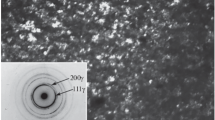Abstract
The Conversion Electron and X-ray Mössbauer studies of the surface of Type 316 stainless steel at 400 K, 300 K, and 100 K show that both the substitutional and interstitial elements perturb the cubic symmetry at the iron site. The single peak of austenite is a superposition of at least five quadrupole split doublets whose magnitudes and intensities depend on the type and concentration of the impurity elements. However, when the surface of the stainless steel is plastically deformed, a layer of martensite about 5000 Å thick is formed on the austenite base. This layer consists of a mixture of 31 pct martensite with the rest being the original austenite. The magnetic environment of the iron in this martensite is controlled by the concentration of alloying elements, and the distribution of the hyperfine fields is determined by the number of nearest and next nearest neighbor impurity atoms. The magnetic field decreases linearly at first as the number of nearest neighbors increases and then follows a nonlinear trend for a number of nearest neighbors. The temperature dependence of the sublattice magnetization is different for each number of neighbors, and a Curie temperature has been estimated for each site.
Similar content being viewed by others
References
G. J. Fisher and R. J. Maciag:Handbook of Stainless Steels. McGraw-Hill: New York, NY, 1977, chs. 1–4.
J. A. Klostermann and W. G. Burgers:Acta Metall., 1964, vol. 12, pp. 355–60.
U. Gonser, R. W. Grant, A. H. Muir, Jr., and H. Weidersich:Acta Metall., 1966, vol. 14, pp. 259–64.
G. P. Huffmann and R. M. Fisher:J. App. Phys., 1967, vol. 38, pp. 735–42.
E. E. Yurchikov, A. Z. Menshikov, and V. A. Tzurin:Proc. Conf. on Appl. of the Mössbauer Effect (Tihany), Akademia Kiado, Budapest, 1971, pp. 413–18.
U. Gonser:An Introduction to Mössbauer Spectroscopy, Plenum Press, New York, NY, 1971, pp. 155–79.
S. A. Antolovich and B. Singh:Metall. Trans., 1971, vol. 2, pp. 2135–41.
L. H. Schwartz and K. J. Kim:Metall. Trans. A, 1976, vol. 7A, pp. 1567–70.
K. J. Kim and L. H. Schwartz:Mat. Sci. Eng., 1978, vol. 33, pp. 5–20.
G. P. Huffman and F. E. Huggins:Mössbauer Effect and its Chemical Applications, American Chemical Society, Washington, DC, 1981, pp. 265–300.
V. V. Sagardze, N. D. Zemtsova, E. I. Starchenko, V. A. Shakashov, and E. E. Urchikov:Fiz. Metal. Metalloved., 1983, vol. 55, pp. 99–110.
N. Hayashi, I. Sakamoto, T. Takahashi, and K. Kuriyama:Proc. Intl. Ion Eng. Conf., Kyoto, 1983, pp. 1919–24.
G. Longworth:Mössbauer Spectroscopy Applied to Inorganic Chemistry Plenum Press, New York, NY, 1984, vol. 1, pp. 227–43.
D. C. Cook and E. Agyekum:Nucl. Instrum. Meth., 1985, vol. B12, pp. 515–20.
D. C. Cook:Hyperfine Interactions, 1986, vol. 29, pp. 1463–66.
C. Wivel and S. Morup:J. Phys. E., 1981, vol. 14, pp. 605–10.
R. Vandenberghe and E. DeGrave: private communication, Laboratory of Magnetism, University of Ghent, Ghent Belgium, 1985.
D. D. Amarisiniwardena, E. De Grave, L. H. Bowen, and S. B. Weed:Clay Min., 1986, in press.
V. N. Bugayev, V. G. Gavrilyuk, V. M. Nadutov, and V. A. Tatarenko:Acta Metall., 1983, vol. 31(3), pp. 407–18.
U. Gonser, C. J. Meechan, A. H. Muir, and H. Weidersich:J. Appl. Phys., 1963, vol. 34(8), pp. 2373–78.
M. Lesoille and P. M. Gielen:Metall. Trans., 1972, vol. 3, pp. 2681–89.
N. DeCristofaro and R. Kaplow:Metall. Trans. A., 1977, vol. 8A, pp. 35–44.
D. L. Williamson, K. Nakazawa, and G. Krauss:Metall. Trans. A, 1979, vol. 10A, pp. 1351–63.
T. Kamenova and R. Banov:Bulg. J. Phys., 1982, vol. 9, pp. 138–50.
V. G. Gavrilyuk and V. M. Nadutov:Phys. Met. Metall., 1983, vol. 55, pp. 520–27.
J. M. Genin and P. A. Flinn:Trans. TMS-AIME, 1968, vol. 242, pp. 1491–30.
C. E. Johnson, M. S. Ridout, T. E. Cranshaw, and P. E. Madsen:Phys. Rev. Lett., 1961, vol. 6, pp. 450–51.
G. K. Wertheim and J. H. Wernick:Phys. Rev., 1961, vol. 123, pp. 755–57.
M. B. Stearns:Phys. Rev., 1963, vol. 129, pp. 1136–44.
G. Shirane, C. W. Chen, P. A. Flinn, and R. Nathius:Phys. Rev., 1963, vol. 131, pp. 183–90.
C. E. Johnson, M. S. Ridout, and T. E. Cranshaw:Proc. Phys. Soc., 1963, vol. 81, pp. 1079–90.
G. K. Wertheim, V. Jaccarino, J. H. Wernick, and D. N. E. Buchanan:Phys. Rev. Lett., 1964, vol. 12, pp. 24–27.
M. B. Stearns:J. Appl. Phys., 1964, vol. 35, pp. 1095–96.
M. B. Stearns and S. S. Wilson:Phys. Rev. Lett., 1964, vol. 13, pp. 313–15.
T. E. Cranshaw, C. E. Johnson, M. S. Ridout, and G. A. Murray:Phys. Lett., 1966, vol. 21, pp. 481–83.
M. B. Stearns:Phys. Rev., 1966, vol. 147, pp. 439–53.
H. L. Marcus and L. H. Schwartz:Phys. Rev., 1967, vol. 162, pp. 259–62.
H. L. Marcus, M. E. Fine, and L. H. SchwartzJ. Appl. Phys., 1967, vol. 38, pp. 4750–58.
F. E. Fujita:Topics in Applied Physics, Springer-Verlag, New York, NY, 1975, vol. 5, pp. 201–36.
U. Gonser, S. Nasu, W. Keune, and O. Weis:Sol. St. Comm., 1975, vol. 17, pp. 233–36.
T. Sohmura and F. E. Fujita:Sol. St. Comm., 1978, vol. 25, pp. 43–46.
J. B. Muller and J. Hesse:Z. Phys. B, 1983, vol. 54, pp. 43–48.
B. Huck, F. Savrenbach, and J. Hesse:Hyperfine Interactions, 1986, vol. 28, pp. 479–82.
J. Hesse and E. Hagen:Hyperfine Interactions, 1986, vol. 28, pp. 475–78.
S. S. Hanna, R. S. Preston, and J. Heberle:Proceedings of the Second International Conference on the Mössbauer Effect, France, Wiley and Son, New York, NY, 1961, pp. 85–89.
J. Heberle:Mössbauer Effect Methodology Plenum Press, New York, NY, vol. 7, pp. 299–308.
J. A. Sawicki and B. D. Sawicka:Hyperfine Interactions, 1983, vol. 13, pp. 199–219.
Author information
Authors and Affiliations
Rights and permissions
About this article
Cite this article
Cook, D.C. Strain induced martensite formation in stainless steel. Metall Trans A 18, 201–210 (1987). https://doi.org/10.1007/BF02825701
Received:
Published:
Issue Date:
DOI: https://doi.org/10.1007/BF02825701



